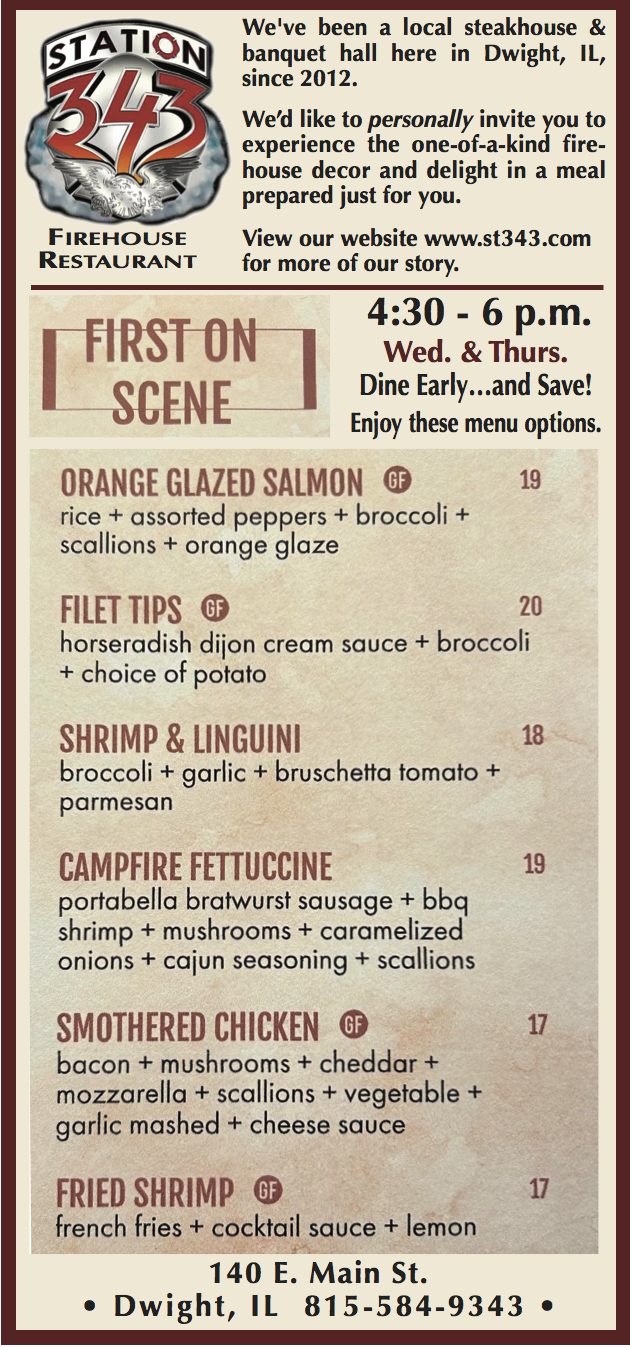By Brandon LaChance
Christmas is part of all of our lives.
Every December we get excited about the holiday and spend time with our families.
Just like everything else in life, there are many different ways to celebrate what many think is the most wonderful time of the year.
The Schultz family does more on Christmas Eve than Christmas Day because this is the way Leonard M. Lipinksi celebrated and shared the last holiday of the year with his family.
“We always followed my dad’s Polish traditions on Christmas Eve,” said Mary Schultz, who teaches eighth grade at Dwight Common School. “He passed away four years ago, but we try to keep the traditions alive. We have modified it a bit, but we keep them alive. As a kid, we always stuck to the true tradition called the Wigilia.
“We go to my grandparents and we’d have the traditional meal, which is a meatless meal. We always had fish. We would start the evening breaking the optatek, which is the Christmas wafer. Everyone gets a piece of the wafer. We stand in a line, the oldest person in the room starts and you wish each other Merry Christmas or a well wish.”
According to the tradition, no one can eat until everyone has broken off a piece of the wafer.
Once the wafer is separated, it’s time for the meal featuring 8-10 parts.
Schultz, who teaches social studies, math, science, and astronomy, remembers as a child eating a soup (usually potato), cheese, sauerkraut, and potato pirogis, stir-fried mushrooms and onions, stewed prunes and apricots, Kasha (a pseudocereal buckwheat Schultz said was disgusting), pickled herring, a vegetable, and a fish whether it was salmon or a white fish.
“We would always set an extra place setting. If there were 10 of us, there would be 10 place settings at the table for the unexpected visitor,” said Schultz, who is married to Scott Schultz. “In Catholicism, if the holy spirit shows up, there is a place for the holy spirit. As kids, we would say it’s for the weary traveler. If they stopped by the house, we had a place for them to sit.
“We would always place straw under the table cloth to commemorate the nativity in the manger.”
Church service is always a must whether it be before dinner or midnight mass.
If the Schultz family was going to the midnight mass they would make sure to get the desserts such as kolacky (Polish cookies) and other sweets demolished. Also, they had to open gifts before mass.
“After we cleaned up, Santa would always come to the house and bring presents,” Schultz said. “We never saw Santa. We would always be downstairs in my grandparent’s basement because they would shoe all the kids downstairs. Bells would ring signaling for us to come upstairs and there would be presents from Santa.”
Although Leonard M. has passed away, Mary Schultz and her family keep some of the traditions alive with her mother Loretta Lipinski. Despite being German, Loretta welcomes the family over for the potato soup, the pirogis, the mushroom and onions. This year they’re going to cheat and have meat, pork tenderloin.
“It’s just always been our tradition and I love the fact that we’re still carrying it on,” Schultz said. “My kids look forward to it every year on Christmas Eve. My kids are 19 (Isabelle Schultz), 21 (Alexander “Bubba” Schultz), and 23 (Nick Schultz), and the first thing my college kids ask is, ‘Are we having potato soup and pirogi at grandma’s house this year?’ I told them, ‘Of course we are.’
“It’s very special to keep the little bit of Polish tradition still going through the family. It keeps the connection with my father going for me and for my kids. My children talk about keeping it going when they have families.”
The Schultz family is not the only family who make unique foods for Christmas.
~ ~ ~
Sandy Kokaly and her family make Potica, which is Croatian.
“It’s a Croatian sweet bread nut roll. It’s delicious,” said Kokaly, who has lived in Dwight for 49 years beginning when she married Joe Kokaly. “My husband’s grandmother (Francis Kokaly, who passed away 10 years ago) taught me how to make it when we first got married. So, I’ve been making it for 49 years. This is a recipe that has been passed down the family.
“She made it her whole life as her mother taught her how to make it.”
Kokaly, who grew up on the outskirts of Reddick, added her entire family enjoys the bread.
Actually, they not only enjoy eating it but they enjoy making it as well.
“I’m excited and the rest of the family is excited that I know how to do it. I’ve taught my two daughters (Sandy Abraham and Katy McCormick) how to make it also,” Kokaly said. “This year we haven’t made it yet, but last year my two daughters, my two granddaughters, and myself made 36 loaves in one afternoon.
“We pass them out to family all across the country (California, Idaho, Arkansas, Texas, and Georgia) and of course keep it to eat it all year long. It freezes very well. Usually, by the time you get to the next winter season and you’re making more, you’re out of what you made the previous year.
“We have fun. We listen to Christmas music and play card games. It’s very important to do this with my family. I love the connection with family and genealogy. Family is very important. There used to be a very large Croatian population in Joliet. Back in the 1960s, they would have a Croatian festival.”
Potica is a yeast bread. After the dough is made it rises for about 1 1/2 hours. Then it is rolled out as thin as possible. Kokaly said she should be able to see her hand through it.
The dough usually covers her tabletop, which is 4×6 feet. A nut filling is spread across the thin dough, it’s rolled up and then set aside to rise for 45 minutes.
After the Potica has reached its bread mountaintop, it is baked for an hour. Then the eating, freezing, and sending begins.
Brandon LaChance is a journalist with The Paper. He can be reached at (815) 876-7941, blachance20@gmail.com, or on Twitter @LaChanceWriter.











































